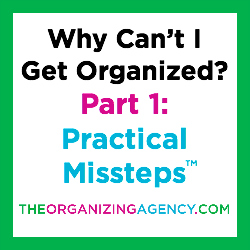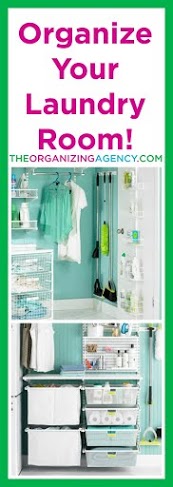Why Can’t I Get Organized? Part 1: Practical Missteps
 Our new blog series is aimed at identifying the real reasons behind your struggles with getting organized. So many people want to have order in their daily lives, but they don’t know where to start. This series of posts will highlight the three categories into which 99% of people fall when it comes to problems with organization: Practical Missteps™, Situational Challenges™, and Internal Obstacles™.
Our new blog series is aimed at identifying the real reasons behind your struggles with getting organized. So many people want to have order in their daily lives, but they don’t know where to start. This series of posts will highlight the three categories into which 99% of people fall when it comes to problems with organization: Practical Missteps™, Situational Challenges™, and Internal Obstacles™.
This week, we’ll look at what specific Practical Missteps may be tripping you up. If you see yourself in any of the following examples, then stay tuned to future blogs for tools and tactics to overcome them once and for all.
Practical Missteps are technical and mechanical mistakes in the way your systems are set up, or they may be a simple lack of know-how. Ill-designed systems lead to chaos, clutter, and tons of time wasted, but if your problems are of a practical nature, they are also the easiest to fix. We find Practical Missteps are in existence 100% of the time.
When assessing a new client’s situation, certain patterns quickly let me know that Practical Missteps are the main hurdle stopping them from getting organized. These patterns include belongings that have no place to live, inconvenient or illogical storage systems, or an overabundance of stuff that doesn’t fit into the available space. These are all problems that can be addressed with straightforward, sensible solutions.
Pattern #1: Items Have No Home/Inconvenient Storage
Do you have piles of stuff everywhere, waiting to be put away, but you don’t know where to put it? Perhaps you’ve tried to use the available closets or shelving, but you find yourself stacking things near, rather than inside, its intended home. If a storage solution is ill-fitted or has restricted access, even the most well-intentioned person will not be inclined to use it.
When stored, items should not be difficult to reach, and storage containers should be chosen specifically for the things they are meant to hold, as well as where they will be used. This means issues of visibility, accessibility and size must be considered while creating your systems. By planning your system according to what needs to be stored, rather than trying to fit your belongings into whatever solution first presents itself, you will create an effective, stress-reducing system that is simple to maintain.
Pattern #2: More Stuff Than Space
If you are constantly putting things away but you find that the STUFF is still taking over your life, you’re facing a Practical Misstep of having more belongings than there is space to accommodate. Even the most organized people can’t fit the ocean in a paper cup. The first solution here is to create additional storage where you can, and secondly, pare down by mastering the Art of the Edit.
The Art of the Edit is a key step in almost every overhaul of an organizing system. When you learn how to employ a logical system to determining what you should keep and what you can let go, you will free yourself from what some people find to be a crippling debate. The decision about what to do with this or that doesn’t have to stop a would-be organizer in their tracks. Applying a simple list of questions will take all the stress out of it, and lead you through a process of unburdening yourself that you might find surprisingly enjoyable! (If your trouble with letting go stems from a deeper fear and it’s the reason you are living with more stuff than your space can fit, then you may fall into the third category, Internal Obstacles, which we will address in a future post.)
Pattern #3: Out of Sight, Out of Mind
If you tend to leave things out so you can see them, stacked on your desk or kitchen counter, or piled by the front door so they’ll catch your attention as soon as you walk in, you’ve probably figured out by now that this is not an effective organizing strategy. Leaving things out as a visual reminder does nothing to help you deal with these tasks, nor does it alleviate your fear of forgetting what needs to get done. With so many things lying around vying for your attention, everything ends up being overlooked amidst the visual clutter.
Once you identify yourself as someone who responds to visual cues then you can work within those parameters to create a more effective organization system. A workable storage solution is the key. Display your things in a way that makes them stand out visually while giving each item a distinct home that is neither hidden from view, nor easy to ignore. Get in the habit of putting reminders on your calendar or setting alarms on your smartphone so you always remember to grab what you need before you go. Perhaps you might try a whiteboard on the back of the door where you write visual reminders for that day or week. By putting things in the same place every time, you create a routine, making it second nature to visit that place daily before you leave the house. Soon you’ll find that forgetting things is no longer a problem for you.
If you think Practical Missteps may be the reason you haven’t yet gotten organized, then keep an eye out for future posts that will take on specifics from how to design a system that will work for you, how to find the right tools and equipment to implement your system, and how to maintain and adjust your systems to stay organized in the New Year and beyond.
Let us know what your organizing goals are for 2015 and what’s been stopping you from getting organized in the past. Ask your questions about Practical Missteps in the comments below and check for our answers in future posts!
















 If you’re planning on preparing your lawn for winter, it’s time to get started. Mid to late October (yes – last week!) is a great time to get your lawn in shape, if you want to groom it for the colder temps of the coming winter season. We’ve organized a few guidelines for a smooth transition. I may live in a condo in Washington, DC, but I really missing having a green yard to take care of. For those of you have an outdoor space to tend to, this post is for you!
If you’re planning on preparing your lawn for winter, it’s time to get started. Mid to late October (yes – last week!) is a great time to get your lawn in shape, if you want to groom it for the colder temps of the coming winter season. We’ve organized a few guidelines for a smooth transition. I may live in a condo in Washington, DC, but I really missing having a green yard to take care of. For those of you have an outdoor space to tend to, this post is for you!
